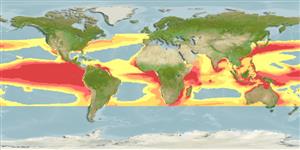Lớp phụ Cá sụn (cá mập và cá đuối) (sharks and rays) >
Myliobatiformes (Stingrays) >
Mobulidae (Devilrays)
Etymology: tarapacana: Named for the Chilean province Tarapacà, where the type specimen was landed.
More on author: Philippi.
Environment: milieu / climate zone / Mức độ sâu / distribution range
Sinh thái học
Biển Cùng sống ở rạn san hô; Ở đại duơng, biển (Ref. 51243); Mức độ sâu 0 - 1896 m (Ref. 117177), usually 0 - 20 m (Ref. 89972). Tropical; 50°N - 37°S, 180°W - 180°E (Ref. 114953)
Circumtropical, recorded from scattered localities. Western Atlantic: off Venezuela. Eastern Atlantic: Côte d'Ivoire and South Africa. Reported from Cape Verde (Ref. 34514). Indian Ocean: northwestern Red Sea and India. Western Pacific: Japan, Taiwan, and probably tropical Australia (Ref. 9911). Eastern Pacific: From Gulf of California to Chile (Ref. 130539).
Length at first maturity / Bộ gần gũi / Khối lượng (Trọng lượng) / Age
Chín muồi sinh dục: Lm 264.8 range ? - ? cm
Max length : 328 cm WD con đực/không giới tính; (Ref. 58048); 305.2 cm WD (female); common length : 250 cm WD con đực/không giới tính; (Ref. 9256); Khối lượng cực đại được công bố: 350.0 kg (Ref. 50641)
A large devil ray with a long head bearing short head fins; dorsal fin plain, and pectoral fins with strongly curved, swept-back tips; upper disc densely covered with small, pointed denticles and tail shorter than disc with no spine (Ref. 5578). Dark blue (Ref. 5578), olive-green to brownish above; ventral side white anteriorly, grey posteriorly, with an irregular but distinct line of demarcation (Ref. 11228). No caudal fin (Ref. 5578).
Body shape (shape guide): other.
Mostly oceanic, but also in coastal waters. Solitary, sometimes forms groups (Ref. 12951). Feeds on small fishes (Ref. 5578) and planktonic crustaceans (Ref. 9911). Ovoviviparous (Ref. 50449). Litter number 1 (Ref. 12951). Sometimes found stranded in beaches in temperate areas (Ref. 9911). Data on female max. length from Ref. 9256. Commonly caught in tuna gillnet and in harpoon fisheries. Utilized for its gill filter plates (very high value), meat, cartilage and skin (Ref. 58048).
Exhibit ovoviparity (aplacental viviparity), with embryos feeding initially on yolk, then receiving additional nourishment from the mother by indirect absorption of uterine fluid enriched with mucus, fat or protein through specialised structures (Ref. 50449).
McEachran, J.D. and G. Notarbartolo di Sciara, 1995. Mobulidae. Mantas, diablos. p. 759-764. In W. Fischer, F. Krupp, W. Schneider, C. Sommer, K.E. Carpenter and V. Niem (eds.) Guia FAO para Identification de Especies para los Fines de la Pesca. Pacifico Centro-Oriental. 3 Vols. FAO, Rome. (Ref. 9256)
IUCN Red List Status (Ref. 130435: Version 2025-1)
Threat to humans
Harmless
Human uses
Các nghề cá: Các nghề cá là sinh kế
Các công cụ
Special reports
Download XML
Các nguồn internet
Estimates based on models
Preferred temperature (Tài liệu tham khảo
123201): 19.4 - 28.9, mean 27.1 °C (based on 1824 cells).
Phylogenetic diversity index (Tài liệu tham khảo
82804): PD
50 = 0.5039 [Uniqueness, from 0.5 = low to 2.0 = high].
Bayesian length-weight: a=0.01000 (0.00244 - 0.04107), b=3.04 (2.81 - 3.27), in cm total length, based on all LWR estimates for this body shape (Ref.
93245).
Mức dinh dưỡng (Tài liệu tham khảo
69278): 3.8 ±0.59 se; based on food items.
Thích nghi nhanh (Tài liệu tham khảo
120179): Rất thấp, thời gian nhân đôi của chủng quần tối thiểu là hơn 14 năm (Fec=1).
Fishing Vulnerability (Ref.
59153): Very high vulnerability (84 of 100).
🛈
